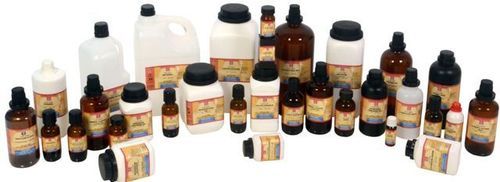Ammonia solution 25%
Ammonia solution 25% Specification
- Usage
- Lab Chemicals
- Storage Instructions
- Dry Place
- Grade
- Industrial
- Type
- Industrial Lab Chemicals
- Application
- Lab Chemicals
- Purity(%)
- 99.99
About Ammonia solution 25%
LC491 Ammonia solution 25%for analysis EMSURE Order number Packaging Quantity Price AC27491 Glass bottle 1 l 13.68 AC27491 Glass bottle 6*1 l 11.61/1 l AC27491 Glass bottle 1 l 10.8 AC27491 Glass bottle 2.5 l 12.15 AC27491 Glass bottle 4*2.5 l 23.4 AC27491 Plastic container 25 l Inquire Product information Synonyms Ammonium hydroxide solution HS Code 2814 20 00 Chemical and physical data Solubility (20 C) soluble Melting point -57.5 C Density 0.903 g/cm3 (20 C) pH value (H2O, 20 C) strongly alkaline Boiling point 37.7 C Vapor pressure 483 hPa (20 C) Explosion limit 15.4 - 33.6 %(V) Safety information according to GHS Hazard Statement(s) H314: Causes severe skin burns and eye damage.H335: May cause respiratory irritation.H400: Very toxic to aquatic life. Precautionary Statement(s) P280: Wear protective gloves/protective clothing/eye protection/face protection.P273: Avoid release to the environment.P301 + P330 + P331: IF SWALLOWED: rinse mouth. Do NOT induce vomiting.P305 + P351 + P338: IF IN EYES: Rinse cautiously with water for several minutes. Remove contact lenses, if present and easy to do. Continue rinsing.P309: IF exposed or if you feel unwell: P310: Immediately call a POISON CENTER or doctor/physician. Signal Word Danger Hazard Pictogram(s) Storage class 8 B Non combustible, corrosive substances WGK WGK 2 water endangering Disposal 13Bases and alcoholates should be diluted if necessary by carefully stirring them into water and then neutralized (protective gloves, fume cupboard!) with hydrochloric acid (Cat. No. 100312). Before placing in container D, check the pH with pH universal indicator strips (Cat. No. 109535). Safety information R Phrase R 34-50Causes burns.Very toxic to aquatic organisms. S Phrase S 26-36/37/39-45-61In case of contact with eyes, rinse immediately with plenty of water and seek medical advice.Wear suitable protective clothing, gloves and eye/face protection.In case of accident or if you feel unwell, seek medical advice immediately (show the label where possible).Avoid release to the environment. Refer to special instructions/ Safety data sheets. Categories of danger corrosive, dangerous for the environment Hazard Symbol Corrosive Dangerous for the environment Transport information Declaration (transport by sea) IMDG-Code UN 2672 AMMONIA SOLUTION, 8, III, Segregation Group: 18 (Alkalis) Declaration (transport by air) IATA-DGR UN 2672 AMMONIA SOLUTION, 8, III Toxicological data LD 50 oral LD50 rat 350 mg/kg Specifications Assay(acidimetric, NH3) 25.0% Carbonate(as CO2) 10ppm Chloride (Cl) 0.5ppm Phosphate (PO4) 0.5ppm Sulphate (SO4) 2ppm Sulphide (S) 0.2ppm Ag (Silver) 0.2ppm Al (Aluminium) 0.500ppm Au (Gold) 0.100ppm Ba (Barium) 0.050ppm Bi (Bismuth) 0.100ppm Ca (Calcium) 0.500ppm Cd (Cadmium) 0.050ppm Cr (Chromium) 0.050ppm Cu (Copper) 0.050ppm Fe (Iron) 0.100ppm Ga (Gallium) 0.100ppm In (Indium) 0.020ppm K (Potassium) 0.020ppm Li (Lithium) 0.500ppm Mg (Magnesium) 0.020ppm Mn (Manganese) 0.100ppm Mo (Molybdenum) 0.050ppm Na (Sodium) 0.050ppm Ni (Nickel) 0.050ppm Pb (Lead) 0.050ppm Pt (Platinum) 0.100ppm Sn (Tin) 0.100ppm Sr (Strontium) 0.100ppm Ti (Titanium) 0.100ppm Tl (Thallium) 0.050ppm Zn (Zinc) 0.100ppm Substances reducing potassium permanganate(as O) 5ppm Residue on ignition(as SO4) 10ppm Non volatile matter 10ppmFAQs of Ammonia solution 25%:
Q: What is the purity level of Ammonia Solution 25%?
A: The purity level of Ammonia Solution 25% is 99.99%.Q: What is the recommended storage condition for Ammonia Solution 25%?
A: Ammonia Solution 25% should be stored in a dry place.Q: What is the application of Ammonia Solution 25%?
A: Ammonia Solution 25% is used as a lab chemical.Q: What grade is the Ammonia Solution 25% classified under?
A: Ammonia Solution 25% is classified as an industrial-grade chemical.Q: Can Ammonia Solution 25% be used for industrial laboratory purposes?
A: Yes, Ammonia Solution 25% is suitable for industrial laboratory purposes.
Tell us about your requirement

Price:
Quantity
Select Unit
- 50
- 100
- 200
- 250
- 500
- 1000+
Additional detail
Mobile number
Email
More Products in Laboratory Chemicals Category
AGAROSE (M) (medium EEO)
Price 1415 INR
Minimum Order Quantity : 10 Grams
Grade : Laboratory Grade
Type : University Lab Chemicals
Purity(%) : 99%
Application : Molecular biology, gel electrophoresis, DNA and RNA separations
ANTIMONY POTASSIUM TARTRATE (trihydrate
Price 2756 INR / Gram
Minimum Order Quantity : 500 Grams, ,
Grade : Laboratory Grade
Type : Other, Inorganic Salt
Purity(%) : 98.5%
Application : Reagent, Mordant, Medicine, Analytical chemistry
Magnesium Manganese
Grade : Industrial Grade
Type : Other, Magnesium Manganese
Purity(%) : 99%
Application : Used as an alloying agent and in batteries
tri-Sodium citrate dihydrate
Grade : Industrial
Type : Industrial Lab Chemicals
Purity(%) : 99.99
Application : Lab Chemicals
We are deals in Lab Chemicals.
"Only deals in retail accepting orders upto 500ml only".
"Only deals in retail accepting orders upto 500ml only".
 |
ALPHA CHEMIKA
All Rights Reserved.(Terms of Use) Developed and Managed by Infocom Network Private Limited. |
 English
English Spanish
Spanish French
French German
German Italian
Italian Chinese (Simplified)
Chinese (Simplified) Japanese
Japanese Korean
Korean Arabic
Arabic Portuguese
Portuguese


 Send Inquiry
Send Inquiry






